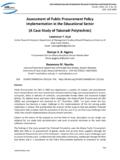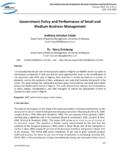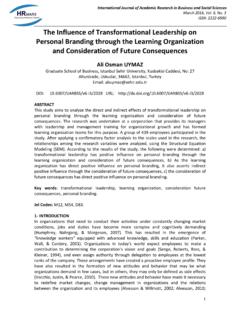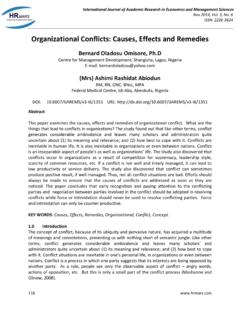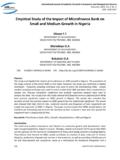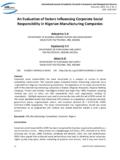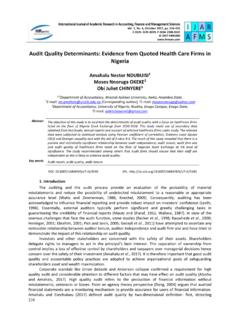Transcription of Evaluation of Survival Strategies of Small and Medium ...
1 255 International Journal of Academic Research in Accounting, Finance and Management Sciences Vol. 4, , April 2014, pp. 255 263 E-ISSN: 2225-8329, P-ISSN: 2308-0337 2014 HRMARS Evaluation of Survival Strategies of Small and Medium Enterprises in Benue State, Nigeria Justin Iorakpen IORUN Department of Accounting, Faculty of Management Sciences, Benue State University, Makurdi, E-mail: Abstract The contributions of Small business enterprises to any economy globally cannot be overemphasized. They are considered as the engine of growth and development of countries; for their contributions to the manufacturing subsector, diversification of output, and reduction of unemployment are immeasurable. Above all, their quick adoption and adaptation of technologies and reduced capital intensiveness provide an effective means of mitigating rural- urban migration.
2 The main objective of this paper is to evaluate the Survival Strategies that will ensure sustained growth of Small and Medium enterprises in Nigeria. Primary data were applied in carrying out this research work. Chi square method was employed to analyze the data. The results reveal that creativity is a strategy for the Survival of Small business enterprises in Nigeria. The results also indicate that high risk taking is a strategy for the Survival of SMEs in Nigeria. Lastly, the results also show that, areas of opportunities for business are a panacea for the Survival of SMEs in Nigeria. It is recommended among others that prospective entrepreneurs should only go into business after taking a realistic view of their strengths and weaknesses and drawing up a well thought out business plan.
3 Also, Government should provide infrastructures necessary to encourage and promote the growth and development of SMEs in Nigeria. Key words Engine of growth, national development, Survival Strategies , entrepreneurial mindset DOI: URL: 1. Introduction Small and Medium enterprises (SMEs) have continued to be a popular phrase in the business world, and thus occupy a place of pride in virtually every country. This is because of the significant role SMEs play as the mainstay of the economic activities in terms of employment generation, national growth, poverty reduction and economic development of global economies including Nigeria. In towns and cities, these businesses employ large percentage of the population.
4 According to Kadiri (2012) cited in Peterise (2003), SMEs both in the formal and informal sectors employ over 60% of the labor force in Nigeria. More so, 70% to 80% of daily necessities in the country are not high tech products, but basic materials produced with little or no automation. Records have shown that SMEs have in many countries provided the mechanism for stimulating private ownership and entrepreneurial skills, enhancing greater employment opportunities per unit of capital invested and aiding the development of local technology (Sule, 1986; World Bank, 1995). Supporting the view above, Ajose (2010) states that SMEs are the pivot of economic growth and first point of contact for the business world. SMEs help to mobilize savings for investment and promote the use of local raw materials.
5 They help diversify economic activity and make significant contribution to exports and trade. SMEs are also important for poverty reduction as they tend to employ poor and low income workers and sometimes they are the source of employment in rural areas and poor regions. Furthermore, by producing intermediate products for use in large enterprises, SMEs contribute to the strengthening of industrial linkages. These explain the increased interest which developing countries have shown in the promotion of SMEs since the 1970s (Ekpenyong and Nyong, 1992). According to Bonga (2010), many economies have lagged behind in the promotion of SMEs and have missed the benefits they bring in a nation.
6 International Journal of Academic Research in Accounting, Finance and Management Sciences Vol. 4 (2), pp. 255 263, 2014 HRMARS 256 Rather, nations have been supporting large scale projects and large companies, which is a good policy but not enough for maximum development of the nations. SMEs spring up in towns and cities almost on a daily basis. No sooner are they established that they fold up mostly within the first few years of operation. What is responsible for this? Several problems limit the growth, Survival and hence effective contribution of SMEs to the economic growth of Nigeria. Lack of conducive and enabling macroeconomic policy environment among other problems remains the drawback to the Survival , development and growth of SMEs (Obitayo, 2001).
7 Appreciation of the most important role of SMEs to the economy, their low Survival capacity and need to enhance the entrepreneurial mindset of Nigerians, encouraged successive Nigerian governments since independence in 1960, to intervene in providing subsidies and other support services for SMEs. The growing concern about unemployment among the youths, especially of graduates of Universities and other tertiary institutions, and diminishing growth potentials in the economy have further drawn increased attention on the need to ensure the Survival and growth of SMEs. The general agreement that has come out is that government should work together with the private sector in creating an adequate enabling environment.
8 Anyanwu (2001:12) posits that, programmes of assistance, especially in the areas of finance, extension and advisory services, training and infrastructural facilities have been designed by governments for the development of the sector. Financing programmes have attracted more attention than others because every enterprise will require funds for its capitalization, working capital rehabilitation needs, as well as for the creation of new investments. Access to finance by businesses has therefore, been of prime interest to policy makers in both the public and private sectors . Inevitable in the discussion of SMEs is the question of what constitutes a Small business enterprise (SBE). Each country tends to derive its own definition based on the role SMEs are expected to play in that economy and the programmes of assistance designed to achieve that goal.
9 Varying definitions among countries may arise from differences in industrial organization at different levels of economic development and differences in economic development in parts of the same country (Sule, 1986). For example, a firm that can be regarded as micro or Small in an economically advanced country like the United States of America or Japan, given their high level of capital intensity and advanced technology, may be classified as Medium or even large in a developing country like Nigeria. Definitions also change overtime, owing to changes in price level, advances in technology or other considerations. Even in the same country, different institutions may adapt different definitions, depending on their policy focus.
10 The criteria that have been used in the definitions include capital investment (fixed assets), annual turnover, gross output and employment. Capital investment and turnover are widely employed because they are easy to measure. However, the impact of price inflation on their values makes it necessary to review them from time to time. Baumback and Lawyer (1979) suggest that qualitative criteria can be used in defining or identifying a Small business. This includes the nature of the firm s ownership and the area of operation. Each of the mentioned yardsticks has its advantages and disadvantages. But according to Sirapolis (1977), the yardstick that uses the number of employees has more in its favor than the others.
